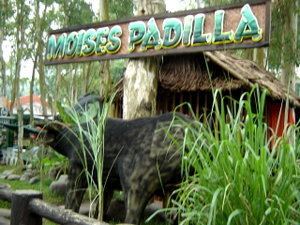Country Philippines Barangays Area 144.1 km² Local time Thursday 2:12 AM Province Negros Occidental | Established 1951 Time zone PST (UTC+8) Population 39,257 (2010) Area code 34 Dialling code 34 | |
 | ||
Region Negros Island Region (NIR) Congr. district 5th district of Negros Occidental Weather 27°C, Wind N at 10 km/h, 94% Humidity | ||
Moises Padilla is a third class municipality in the province of Negros Occidental, Philippines. According to the 2010 census, it has a population of 39,257 people. Moises Padilla was formerly called Magallon.
Contents
- Map of Moises Padilla Negros Occidental Philippines
- Geography
- History
- Demographics
- Economy
- Transportation
- References
Map of Moises Padilla, Negros Occidental, Philippines
The town is famous for its vast livestock yard, the major source of income of the town. Traders all over the island of Negros come to buy, sell, and trade all kinds of farm and dairy animals. The town's official emblem shows the "Carabao" or the Water buffalo.
Geography
Moises Padilla is situated in central part of Negros Island. The location of the town is best for viewing the Kanlaon Volcano in its near perfect cone shape. Along the east side part of the town is the longest river in Negros Island, the Binalbagan River.
The town is amazingly having its natural spring water right in the heart of the town. Large concrete storage tanks are constructed to store the eternal supply of clean and fresh water. No mechanical device is needed to extract the rare wealth, it's just flowing free and filled the tanks endlessly throughout the whole town.
Moises Padilla is politically subdivided into 15 barangays.
History
Three miles north from the town is a small sitio called Magallon Cadre. Here lie the ruins of field hospital of the U.S. Army and USAFFE before the World War II. Magallon had witnessed the brutality and terror of World War II. However no event was ever recorded in public documents. It is believed and verified by older citizens that the opening attack of Japanese invaders were sending the two well-armed Mitsubishi Zero fighters. The Japanese commander had chosen cleverly to initiate the attack during the market day of the Magallon which is every Tuesdays; where the large population gathered and met to buy food, clothing, farm tools, and everything of value. According to witnesses, the two Japanese Zero fighters began their low level flight from Crossing Magallon all the way to the heart of Magallon that have a distance of about 7 kilometers. They strafed any thing that moves in the road; people, children, and animals of all kinds. They finally dropped their two lethal cargoes of bombs right in the center of the market. After recovering from initial shock, the Japanese infantry began pouring in from every direction of the barangay.
In 1951, the barrios of Magallon, Odiong and Guinpanaan, then belonging to the town of Isabela, were separated to form the town of Magallon. The boundary between the two towns were as surveyed by the Bureau of lands in accordance with Resolution No. 1. of the joint session of the Provincial Board of Negros Occidental and the Municipal Council of Isabela dated November 15, 1949, and subsequently concurred to by Resolution No. 79 of the Municipal Council of Isabela dated December 26, 1949.
In 1957, the town was renamed to Moises Padilla, a public figure who was tortured and killed for political reasons by assassins of former Governor Rafael Lacson in Negros Island. Padilla was declared a martyr by the late Ramon Magsaysay, then a Secretary of National Defense during the early 1950s. It was believed that Moises Padilla was an ardent supporter of Magsaysay in every political arena after the war.
Demographics
Languages spoken are Hiligaynon; Cebuano; Tagalog; English
Majority people are Christians.
Economy
Sugarcane; rice; corn; root crops; lumber; livestock
Transportation
Regular trips of bus and other utility vehicles to and from Bacolod City, Canlaon City in Negros Oriental, and Cebu City.
